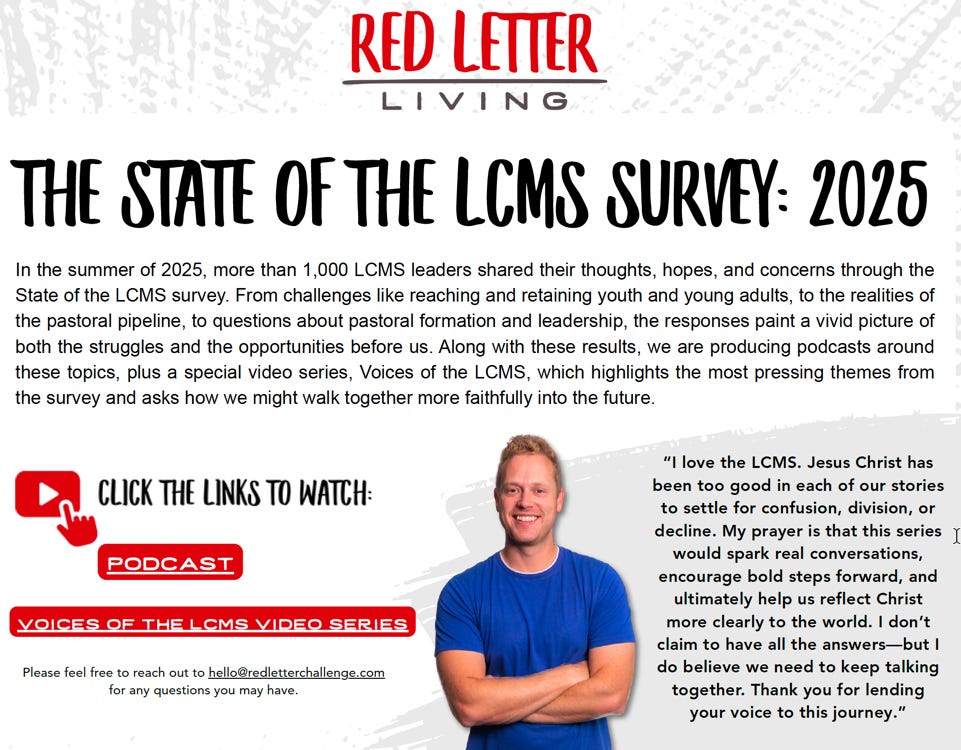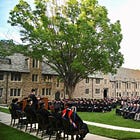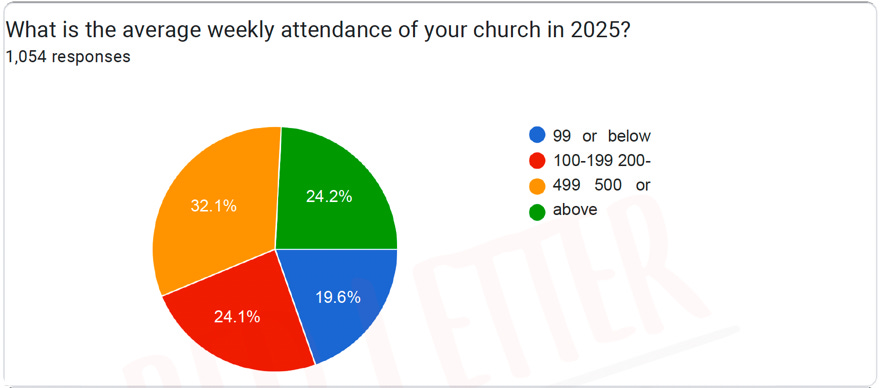The Red Letter LCMS Survey: Problems, Premises, and Partiality
Why a popular 2025 Synod-wide survey probably reveals more about its participants than about the Synod itself.
In the summer of 2025, over a thousand LCMS members responded to a Red Letter Challenge initiative, which the organization hailed as a landmark effort to gauge the church’s vitality. Red Letter Challenge launched the State of the LCMS Survey. It promoted it via the Voices of the LCMS video, encouraging pastors and leaders to share insights on pastoral formation, youth engagement, synodical leadership, and the future of congregational life.
The resulting report and video struck a chord with those who believe that the Synod’s structures have become so sclerotic that they are almost beyond recovery. Charts and soundbites spread quickly across social media, and the State of the LCMS Survey is being cited as hard evidence that the Synod’s governance and culture are broken—a conclusion that deserves closer scrutiny.
To properly digest the import of the survey, we need to know
Who took this survey—and who didn’t?
What assumptions were built into its design?
How might its interpretation serve a particular theological or organizational agenda rather than a neutral inquiry?
1. Overview and Premise
The 2025 State of the LCMS Survey, claiming responses from 1,054 “LCMS leaders,” aims to diagnose Synod life and spark renewed dialogue and reform, as framed by its author, Pastor Zack Zehnder. Yet, Zehnder’s prior criticism of LCMS leadership, specifically for pressuring Pastor Tim Ahlman to apologize over his remarks on ordination pathways, set the survey’s premise and tone, predisposing its questions and responses to highlight systemic dysfunction, thus skewing its outcomes:
Ahlman is silenced ➤ innovators are distrusted and disregarded ➤ the LCMS is dying.
Apologizing for dissent ➤ a culture of fear ➤ the institution is terminally ill.
Consequently, the methodology and framing of the LCMS survey reduce its representativeness. It is a self-reflective instrument of the “missional” constituency rather than a representative survey of the Synod as a whole.
2. Sampling and Representation Problems
a. Quantitative Gaps and Analytical Weaknesses
The report offers little methodological transparency, lacking weighting, a margin of error, or cross-tabulation by region or size. Every response counts equally, regardless of whether the church has 20 members or 2,000. Ironically, this reproduces the very “one congregation, one vote” dynamic the survey criticizes as unjust.
Moreover, the survey’s authors conducted no statistical testing to determine whether the differences reflect significant trends or were merely anecdotal. This produces a collection of percentages lacking proportion, data lacking depth, and results lacking the rigor needed to inspire confidence in their validity.
b. Self-Selection and Recruitment Bias
The survey was circulated through Red Letter Challenge mailing lists and social platforms. That audience is overwhelmingly composed of pastors and leaders already sympathetic to the missional, church growth/entrepreneurial model of ministry. There is insufficient evidence of random sampling, district coordination, or stratification by geography or parish size. Zehnder does acknowledge these flaws.
Ultimately, this reduces the data to a function of who saw the link and cared enough to respond, not the LCMS as a whole. Congregations skeptical of “missional” rhetoric or initiatives were unlikely even to encounter it.
c. Skewed Age and Context
While the survey reports age ranges (most between 30 and 59), it omits location, ethnicity, and rural–urban distribution. In a Synod where the median congregation worships fewer than 100 people each Sunday, the absence of this context conceals a massive imbalance. The responses overwhelmingly reflect suburban and large-church contexts, not the thousands of small, rural parishes that make up the Synod’s backbone. These large churches are almost uniformly “missional” in their outlook, attitudes, and behavior.1
d. Incomplete Disclosure of Respondent Roles
The survey reports that just over 53% of respondents identified as pastors. Still, it offers no breakdown of what kinds of pastors these were—senior, associate, assistant, SMP (Specific Ministry Pastor), or retired clergy. Without such differentiation, the category “pastor” masks an enormous diversity or concentration of experience and influence.
For example, a senior pastor of a 2,000-member congregation has a vastly different vantage point than an associate pastor in a suburban staff model or a sole pastor serving a rural parish of 40 members, comprising 75% female members with an average age of 76. Each would interpret “representation,” “leadership,” and “support” in very different ways. Treating them as a single block erases those distinctions and weakens the interpretive value of the data.
Similarly, while the survey implies that nearly half of the respondents were laity or non-pastoral workers, it provides no details about their roles—whether they were elders, professors, teachers, DCEs, school administrators, commissioned ministers, or simply interested lay members. The absence of this context inhibits any meaningful comparison of how clergy and lay perspectives converge or diverge.
It is understandable that many pastors and congregations, especially those experiencing growth and vitality or having the largest congregations, feel frustrated by a system that limits them to the same formal vote as a fractionally sized parish. Their budgets are heavier, their staffs larger, and their ministries often far more complex. They see themselves carrying a disproportionate share of the Synod’s financial and missional load, and that perception of imbalance can easily foster a sense of disenfranchisement.
Yet it is equally valid that this is the very system to which these congregations subscribed. The LCMS was founded not as a “proportional republic,” and it was precisely to prevent power from concentrating among the wealthy, the populous, or the prominent. Each congregation voluntarily enters what amounts to an association of equality, recognizing that unity in doctrine and mission, not scale or influence, circumscribes representation. Dissatisfaction with the consequences of that structure does not make it unjust—it simply reminds us that equality in the body of Christ will always sit uneasily beside the inequalities of size and strength in the world.
3. Framing and Leading Questions
Several survey items have loaded phrasing that pre-determines the direction of response.
“Too much power concentrated in top leadership” assumes agreement that centralization is a problem.
“Adapting to digital ministry and technology” is listed as a challenge, implying urgency and virtue in innovation.
“The role of women in the church” is offered without definition, leaving respondents to guess what “role” means.
One respondent even noted this bias explicitly, objecting that the questions were “leading,” “unbalanced,” and “assume too much.”
Such wording steers participants toward a pre-selected narrative: that the LCMS is hierarchical, outdated, and indifferent to innovation.
4. Narrative Bias and Slanted Interpretation
The episode titled “Taxation Without Representation” interprets the survey data through an untested hypothesis: that the Synod’s greatest systemic failure lies in its unwillingness to “trust” and “listen to” large, growing congregations. Zehnder presents this conclusion not as speculation but as an established fact—“the data backs it up with exclamation points.” Yet the claim rests on a veneer of anecdote, sentiment, and selective inference, rather than verifiable analysis.
The episode’s rhetorical centerpiece is a quote from former president Jerry Kieschnick:
“Can you help me understand, sir, why our congregation is paying on the basis of 800 members, yet those 800 people have zero representation at our national convention? … That’s taxation without representation, and something’s got to give.”
It’s a classic Kieschnick soundbite—and a politically loaded one, as usual. But the analogy falters on both theological and historical grounds.
a. Misapplied Political Metaphor
The LCMS has never operated on a proportional-representation or simple-majority model. From its 1847 founding onward, the Synod has understood itself as a federation of autonomous congregations agreeing to walk together bound by a shared confession, not as a parliamentary democracy in which financial contributions determine legislative weight. Each member congregation, whether of 20 or 2,000 souls, sends a pastoral and lay delegate to its circuit and district conventions, and in turn elects delegates to the national convention.
The LCMS was never intended to be a majority-rule body.2 Its founders rejected the notion that size or wealth should buy greater influence. Each congregation—large or small—has the same standing before Christ and the same voice in the Synod’s deliberations. Calling that arrangement “taxation without representation” borrows the language of politics and economics for something that isn’t political at all. Congregations don’t pay taxes; they pool their gifts for shared mission.
The bond of our “walk together” isn’t measured in budgets or membership rolls, but in faithfulness—the same truth captured in the parables of the Widow’s Mite and the Mustard Seed. As Rev. Dr. Adam Koontz notes in his Family Bible Commentary, Vol. IV, the growth of God’s kingdom comes about solely through His own work, not man’s, and highlights the hidden yet transformative nature of the kingdom. It remains at all times mysterious and beyond our comprehension, yet true, tangible, and effective.
1 My brethren, do not hold the faith of our Lord Jesus Christ, the Lord of glory, with partiality. 2 For if there should come into your assembly a man with gold rings, in fine apparel, and there should also come in a poor man in filthy clothes, 3 and you pay attention to the one wearing the fine clothes and say to him, “You sit here in a good place,” and say to the poor man, “You stand there,” or, “Sit here at my footstool,” 4 have you not shown partiality among yourselves, and become judges with evil thoughts?
5 Listen, my beloved brethren: Has God not chosen the poor of this world to be rich in faith and heirs of the kingdom which He promised to those who love Him? 6 But you have dishonored the poor man. Do not the rich oppress you and drag you into the courts? 7 Do they not blaspheme that noble name by which you are called?
b. Selective Reading of the Data
Zehnder seizes on a single data point—fewer than 20 percent of respondents believe the current structure gives larger or growing congregations a voice—and treats it as conclusive proof of institutional bias. Yet the survey never identifies who those respondents are or whether they actually serve in such congregations. Nor does it define what “having a voice” means in practice: proportional representation at conventions, quota-managed seats on boards and committees, veto power over resolutions, or some style of informal visibility within the Synod?
c. From Perception to Polemic
Zehnder extends this interpretation into a moral drama. Pastors of larger churches, he says, “feel hunted,” “isolated,” and “silenced,” while smaller congregations are described as the “backbone” yet somehow complicit in the system that mistrusts innovation. This rhetorical device reinforces a narrative of persecution—large churches as prophets without honor in their own Synod—without acknowledging that the LCMS’s polity is designed precisely to prevent dominance by any class or size of congregation.
d. Dueling Constituencies?
The “taxation without representation” reading, therefore, confuses representation with influence and financial contribution with authority. Its argument turns a constitutional feature—the equality of congregations—into evidence of oppression and alienation. In doing so, it replaces theological categories of vocation and fellowship with political categories of equity and enfranchisement.
It also overlooks the role of many respondents in sustaining the very dynamics they condemn. The pastors and leaders most active in the “missional” network have built their own parallel ecosystems: NGO-style institutes, conferences, and media channels that function primarily outside the Synod’s normal processes of deliberation and fellowship. Their preference for entrepreneurial freedom in worship, governance, and pastoral formation has, ironically, deepened the very fragmentation and mistrust they now attribute to Synod leadership. To cast themselves only as victims of exclusion is to ignore their own part in widening the divisions and building the power structures they now lament.
Ultimately, the narrative affirms the convictions of its interpreters. It promotes a kind of megachurch exceptionalism that treats numerical growth as proof of divine favor and congregation size as a proxy for theological or institutional authority—all while misreading the Synod’s polity as if it were a civil democracy rather than a fellowship of evangelical-Lutheran congregations bound by confession, rather than as an eternal power struggle between dueling constituencies.
5. Other Observations
To its credit, the Red Letter survey surfaces several concerns that should not be brushed aside just because of the problems noted above:
Widespread distrust in national leadership (with over 40% “not confident”).
Ongoing decline in attendance and youth retention.
A desire for open dialogue and transparency.
These issues deserve attention across theological and ideological lines. But they must be tested through more reliable research—balanced by geographic, theological, and demographic representation.
A more effective synod-wide study would:
Include laity and district-level voices.
Weight results by congregation size, region, sex, and commission or non-commission status.
Employ neutral, non-leading phrasing.
Distinguish descriptive data from advocacy.
Conclusion
The State of the LCMS Survey (2025) is an earnest attempt to improve dialogue and stop the factional sniping, but it is not a reliable gauge of the Synod’s health or consensus. It amplifies the voices of one segment—large, missionally inclined congregations—while underrepresenting the rest.
By so emphatically portraying the LCMS as distrustful of innovation and hostile to growth, it risks reinforcing division rather than cultivating genuine fellowship. That said, we can acknowledge Zehnder’s advocacy without either dismissing or sanctifying his research. The dataset contains truth, but it is not the truth without more work.
☩TW☩
Generally speaking, in the LCMS, “missional” refers to a movement of pastors and congregations that emphasize outward growth, cultural engagement, and “adaptive” ministry—often characterized by entrepreneurial leadership, contemporary or blended worship styles, and the use of non-Synodical or self-created teaching and worship materials in place of officially approved hymnals and resources.
The constitution of the Lutheran Church—Missouri Synod does not employ proportional or majority representation but a federative structure grounded in congregational equality. Each member congregation is a self-governing entity that voluntarily joins the Synod for consultation and cooperation in confession, mission, and education. Representation at the national convention is indirect: each congregation elects a pastoral and a lay delegate to its circuit forum; and the circuit forum elects delegates to the Synodical convention (Const. Art. IX; Bylaws 3.1–3.2). Every parish, regardless of communicant membership or financial contribution, is accorded the same delegate weight.







Excellent and thorough analysis. Surveys like polls and statistics need to be analyzed if they are to have any informative value.
So the LCMS is hierarchical, antiquated, and indifferent to innovation? I’m not seeing a problem here. That describes the one, holy, catholic, and apostolic Church on earth.
Several thoughts: 1) Both the survey and the response are helpful, in my opinion.
2) Weaknesses in the survey from a professional survey criteria point of view are important to point out. The overall shared perspective is that denominational decline in membership is rolling down the road at an ever-increasing pace. The Red Letter group, ie large congregations with diverse worship forms, addresses it directly in its prioritization of Gospel outreach to families and to the community surrounding. That's good! 3) Synod, from the Greek for "same road", is not defined as lockstep uniformity in practice. We're walking down the same road TOGETHER. The old guru Lyle Schaller described it not as "marching" but as pilgrimage. We're on the highway to heaven as pilgrims on a journey. Some walk slower, some with more pace, there are stops along the way for refreshment and to care for the sick and those in need of special care. The highway, the Way, is Jesus. All the doctrinal accoutrements serve to reveal Jesus through the Word, through Water, through the Meal. The relationship is with God and God's community. 4) Red Letter describes to me a desire - and it's a desire to be at the decision tables in the LCMS as we all walk down the road. The group of congregations representing the majority of LCMS Lutherans at worship on Sunday is not involved at the national leadership and decision-making level. That's actually difficult to understand for them, and for any objective observer.
5) Why is that? How does that happen? First, it's on purpose, mostly purposefully because of the diversity of worship style in the various and many worship offerings of those large congregations. It manifests at the national youth gathering, where they send boatloads of kids who are not locked in only to LSB. So, 6) the group running the elections and selections in the LCMS doesn't like that some of the pilgrims on the journey are not locked in only to LSB. That group purposefully keeps those folks away from leadership at the national level. 7) That group is uniquely anonymous among Christian denominations in the US. It's called the United List.
8) So in closing, Red Letter has a legitimate desire, and a legitimate beef. It can't direct the beef to the folks running the election, because they're unknown. It really hasn't even been articulating the desire and distress until the last couple of years.
9) Do they deserve to be heard?